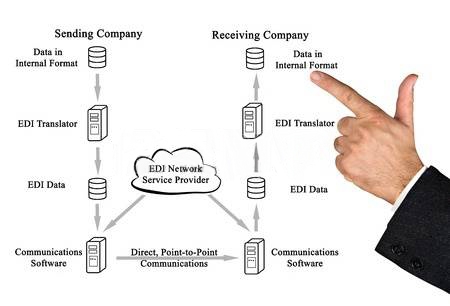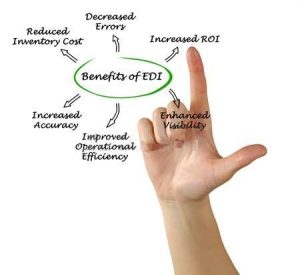
 Data Structure
Data Structure Networking
Networking RDBMS
RDBMS Operating System
Operating System Java
Java MS Excel
MS Excel iOS
iOS HTML
HTML CSS
CSS Android
Android Python
Python C Programming
C Programming C++
C++ C#
C# MongoDB
MongoDB MySQL
MySQL Javascript
Javascript PHP
PHP
- Selected Reading
- UPSC IAS Exams Notes
- Developer's Best Practices
- Questions and Answers
- Effective Resume Writing
- HR Interview Questions
- Computer Glossary
- Who is Who
Electronic data interchange edi safe and secure global communication
For many years, companies have been using computers to send business documents instead of mailing paper documents. But the problem arises when Company A won’t recognize e-format of Company B due to the absence of a standard format which led to the condition where computers could no longer “talk” to one another and again a great deal of effort by programmers need to put which led the cost.
In 1979 the American National Standards Institute (ANSI) formed the Accredited Standards Committee (ASC) X12 to rectify this situation. This committee was to standardize the format of electronic documents to allow for easy movement of information between computers.

EDI (Electronic Data Interchange) is a standard format for computer-to-computer exchange of business documents between companies.
EDI is based on the use of message standards, ensuring that all participants use a common language. A message standard consists of uniform formats for business documents, which have been adopted for electronic transmission purposes. It also includes security and control elements and other rules and conventions relating to the use of transaction sets that all users agree to follow.

“EDI” constitutes the entire electronic data interchange paradigm including the transmission, message flow, document format, and software used to interpret the documents.
EDI can be transmitted using any methodology agreed to by the sender and recipient.
This includes a variety of technologies, including modem (asynchronous and synchronous), FTP, e-mail, HTTP, AS1, AS2, etc.
Some Major Sets of EDI Standards
- UN/EDIFACT: This is only internationally recognized standard and is predominant outside of North America.
- ANSI ASC X12 (X12): This is the standard predominant in North America.
- TRADACOM: – This standard is developed by the ANA (Article Numbering Association now known as GS1) which is used by British retail companies.
- ODETTE: – This standard is used by European automotive industry.
EDI Terminology
- Trading Partners: Organizations that send or receive documents between each other are referred to as trading partners. The trading partners agree on the specific information to be transmitted and how it should be used.
- Mapping: This term is typically reserved for specific machine-readable instructions given to the translation software. Often in a large company these EDI guidelines will be written to be generic enough to be used by different branches or divisions and therefore will contain information not needed for a particular business document exchange. For other large companies, they may create separate EDI guidelines for each branch/division.
- Transmission: The sending and receiving party involved in the exchange of EDI transmissions.VAN is mostly used prominent transmission method for EDI, Though some organization have used direct modem to modem connections and bulletin board systems (BBS) and more popular internet protocols .
- VAN (Value added Network): A third party network that acts as an intermediary between trading partners .this service apart of receiving , storing , receiving and delivering the EDI messages also add audit data and modify data for automatic error detection, correction or conversion between communication protocols.
- Translator: An EDI translator has traditionally been used to take data from a business application and map it into EDI standard formats. The process of developing a map is called EDI mapping and the EDI software is sometimes referred to as an EDI Mapper. Some EDI translators (mappers) come with the ability for the user to generate the maps and some do not, requiring the user to purchase maps from the vendor.
- EDI Processes: A typical EDI exchange involves the following processes: Inbound Process and Outbound process.
The outbound process includes, generating and sending of EDI files.
Below are the steps of an outbound process.
- Obtain data from existing system.
- Generate EDI file.
- Validate EDI file.
- Send EDI file to trading partner.
Some common methods of transmission are FTP, HTTP and AS2.
The inbound process is the receiving and translating of EDI files.
Below are the steps of an inbound process.
- Get EDI file
- Validate and acknowledge EDI file be sending back a TA1, 997 or CONTRL EDI file.
- Translate EDI file.
- Save data to a database.
Benefits of using EDI

Economy: Research has consistently shown that EDI costs only one third of its paper-based equivalent. Expenses associated with paper, printing, reproduction, storage, filing, postage and document retrieval are all reduced or eliminated when we switch to EDI transactions.
Speed: Information moving between computers moves more rapidly, and with little or no human intervention.EDI can speed up our business cycles by 61%.it can reduce the order-to-cash cycle time by more than 20%, improving business partner transactions and relationships. Transactions that used to take 5 days by paper can be completed in under an hour.
Accuracy: Information that passes directly between computers without having to be re-entered eliminates the chance of data entry errors. There is almost no chance that the receiving computer will invert digits or add an extra digit. Improves data quality, delivering at least a 30—40% reduction in transactions with errors by eliminating errors from illegible handwriting, lost faxes/mail and keying and re-keying errors.
Efficiency: Automating paper-based tasks allows our staff to concentrate on higher-value tasks and provides them with the tools to be more productive. Shortening the order processing and delivery times means that organizations can reduce their inventory levels. Research reports as much as a 50% savings on human resources from the use of EDI.
Strategic Business Level: Enables real-time visibility into transaction status. This in turn enables faster decision-making and improved responsiveness to changing customer and market demands, and allows businesses to adopt a demand-driven business model rather than a supply-driven one. Shortens the lead times for product enhancements and new product delivery.

